
The artist’s wife, Gala Dalí, inspired the endlessly decomposing and composing portrait. Spanish surrealist Salvador Dalí’s Galatea of the Spheres was undertaken at a moment of intense global anxiety at the prospect of nuclear armageddon and reveals Dalí’s own accelerating preoccupation with atomic theory in the years following the US nuclear attacks on Japan in 1945. Zoom out, and the seemingly lawless rush of spheres cohere loosely into the coy countenance of a woman’s bust, her head tilted gently in a manner that recalls countless Renaissance madonnas. (Credit: Wikimedia Commons)Īt first glance, the dynamic painting appears to capture the outward propulsion, towards the viewer, of countless colourful atoms – as if suspending in mid-blast a nuclear explosion occurring over a watery expanse.


Seen from a 21st Century perspective, the inherent preachiness of the drawing (which visually puns on the scriptural admonishment “Vanity of vanities, saith the Preacher, vanity of vanities all is vanity”) seems more than a little misogynistic in its emphasis on feminine narcissism as the chief locus of damnable frivolity and vice. A contrivance of the illustrator Charles Allan Gilbert, the drawing offered American magazine readers in the closing years of the 19th Century a fresh and startling spin on the convention of the memento mori (or ‘remember you will die’) in art history, which typically took the form of a skull inserted somewhere in a painting to remind viewers of their mortality. Once the two overlapping images are registered in the observer’s mind, the eye shuttles between comprehension of one and then the other, as they wrestle for priority. Step back, and the image, deprived of its scrutinisable details, curdles grimly into an all-encompassing skull, grinning gothically from the shadows. Stand close to the black-and-white drawing and it appears to be little more than a depiction of a familiar domestic interior scene: a woman sitting at her dressing table (or “vanity”) staring at her reflection in the mirror opposite. Believed to be the first artist since antiquity to employ such an illusion as a dimension of interior design, Mantegna breathed new religious life into a pagan trick. Mantegna saw the flat surface of a canvas or ceiling as an opportunity to take an observer’s eye and soul on a spiritual journey inwards, upwards, and outwards. The evaporative effect is the handiwork of Italian artist Andrea Mantegna – a genius of dramatic foreshortened perspective and depicting figures illusionistically di sotto in sù (or “below upwards”). Impossibly, the barrier of the ceiling appears to have dissolved, revealing an invisible architecture that telescopes towards heaven, thrusting your soul in the direction of the divine.

Suddenly, a shaft of unalterably beautiful blue sky beckons through a round aperture (or oculus) rimmed with angelic figures. To stand in the centre of the medieval bridal chamber of the Ducal Palace in Mantua and look up is to see the enclosed space magically widen above you. The result is a work that is at once amusing and profound – one that reminds the observer not only of the perishability of life but how our physical existence is comprised, materially, of the fragile world around us. Painted by the 16th Century Milanese Mannerist Giuseppe Arcimboldo, who would later inspire the imaginations of 20th Century Surrealist painters, Reversible Head With Basket of Fruit tricks the eye into the restless exercise of constructing and destroying one image in favour of the other. The fibrous lashes of his chestnut eye wink at you playfully to punctuate the visual joke. Flip the oil-on-panel work on its head, as if shaking loose the fruit that fills the wicker basket, and suddenly the plumped-up portrait of a stranger assembles itself from the bright jumble of assorted sweetness. Tilt the painting one way and it is a vibrant heap of autumnal bounty, as apples, pears, grapes, and figs puzzle for position in an alluring, if seemingly conventional, still life.


 0 kommentar(er)
0 kommentar(er)
